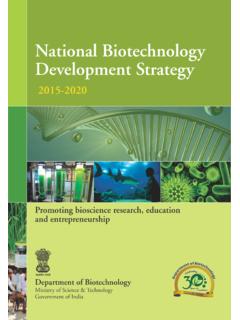Transcription of Paris, 3-4 June 2015 OECD WEEK 2015
1 OECD WEEK2015 Meeting of the OECD Councilat Ministerial LevelParis, 3-4 june 2015 Paris2, rue Andr -Pascal, 75775 paris Cedex 16 Tel.: +33 (0) 1 45 24 82 00 OECD INNOVATION STRATEGY 2015AN AGENDA FOR POLICY ACTION OECD Innovation Strategy 2015 An Agenda for Policy Action 2 1. The OECD released the Innovation Strategy in 2010. The Strategy was one of the first dedicated horizontal projects in the OECD. Since its launch, it has been well received and affected policy developments in many countries. In his 2013 Strategic Orientations, the Secretary-General pointed to the need to revisit and update the Innovation Strategy and the 2014 OECD Ministerial Council Meeting (MCM) signalled the importance of carrying out such update.
2 2. The 2015 version of the OECD Innovation Strategy was co-ordinated by STI and draws on the work of 14 OECD Directorates that contributed in areas such as green innovation (ENV, IEA, NEA, STD and STI), public sector innovation (GOV, EDU and STI), health innovation (ELS and STI), inclusive innovation (STI, STD, GOV and EDU), agricultural innovation (TAD), country-specific innovation policies (STI, DEV and ECO), as well as issues such as governance and risk governance (GOV, ENV and STI), skills (EDU, ELS, CFE, ECO and STI), business environment (ECO, DAF, TAD, CFE and STI), knowledge creation and diffusion (STI) and specific innovation policies (CFE, CTPA, GOV and STI).
3 The OECD Committee for Scientific and Technological Policy (CSTP) and the Committee on Industry, Innovation and Entrepreneurship (CIIE) took the lead in developing this update, with other OECD Committees providing substantive input in their respective areas of competence. A synthesis of the work is being delivered to the 2015 MCM, and a longer version of the report will be presented at the meeting of the CSTP at Ministerial level, to be held in Daejeon, Korea, in October 2015 . Executive Summary 3. New sources of growth are urgently needed to help the world move to a stronger, more inclusive and sustainable growth path following the financial crisis.
4 Innovation which involves the creation and diffusion of new products, processes and methods can be a critical part of the solution. While not a goal in itself, innovation provides the foundation for new businesses, new jobs and productivity growth and is thus an important driver of economic growth and development. Innovation can help address pressing social and global challenges, including demographic shifts, resource scarcity and the changing climate. Moreover, innovation can help address these challenges at the lowest cost. Innovative economies are more productive, more resilient, more adaptable to change and better able to support higher living standards.
5 4. Governments play a key role in fostering a sound environment for innovation, in investing in the foundations for innovation, in helping overcome certain barriers to innovation, and in ensuring that innovation contributes to key goals of public policy. The OECD Innovation Strategy 2015 sets out a concrete agenda to strengthen innovation performance and put it to use for stronger, greener and more inclusive growth. The Strategy sets out 5 priorities for policy makers that together provide the basis for a comprehensive and action-oriented approach to innovation, much of which can also be applied in the context of fiscally constrained economies.
6 These priorities are: 1. Strengthen investment in innovation and foster business dynamism 2. Invest in and shape an efficient system of knowledge creation and diffusion 3. Seize the benefits of the digital economy 4. Foster talent and skills and optimise their use 5. Improve the governance and implementation of policies for innovation 5. Implementing an effective government strategy for innovation is particularly important as key trends the spread of global value chains, the increasing importance and mainstreaming of knowledge-based capital (KBC), and rapid technological progress, including the rise of the digital economy are 3 leading to the emergence of a next production revolution (OECD, 2015a).
7 In the current context of a weak global recovery, business and policy leaders need to take advantage of these trends to accelerate structural shifts towards a stronger and more sustainable economic future that creates new jobs and opportunities. The remainder of this paper briefly sets out the broader context for innovation and elaborates on the five priorities for policy action. Why innovation? 6. Innovation underpins the growth and dynamism of all economies. In many OECD countries, firms now invest as much in the knowledge-based assets that drive innovation, such as software, databases, research and development (R&D), firm-specific skills and organisational capital, as they do in physical capital, such as machinery, equipment or buildings.
8 Moreover, billions of people around the world, including in emerging economies, today have access to the Internet and are connected to one another, enabling knowledge diffusion and the creation of further innovations. The proliferation of massive amounts of data (such as geolocation data from mobile phones) is just a hint of what can be expected from the emergence of ubiquitous data generation and computing characterised as the Internet of Things . These, and other technological changes in fields like bio- and nano-technology and the associated advanced materials, will lead to ongoing transformations in the nature of production, jobs, the location of economic activity, and the respective roles of different sectors in the economy (OECD, 2015a).
9 Figure 1. Contributions to GDP growth Total economy, annual percentage point contribution, 1995-2013 Source: OECD (2015b), OECD Compendium of Productivity Indicators, 2015 , based on OECD Productivity Database, January 2015 . 7. Such technological changes and related non-technological innovations are an important driver of growth. Empirical analysis shows that innovation, in its various forms, contributes to growth through several channels: A contribution resulting from technological progress embodied in physical capital. The latest OECD estimates show that about percentage points of annual average GDP growth between 1995 and 2013 can be attributed to investment in information and communications technology (ICT) capital alone [Figure 1; OECD, 2015b].
10 -1012345 ITAJPNDNKDEUFRAPRTBELNLDAUTCHEGBRESPFINS WEUSACANNZLAUSIRLKORM ultifactor productivityNon-ICT capitalICT capitalLabour input 4 A contribution resulting from investment in KBC, such as R&D, design and other intellectual property, data, firm-specific skills or organisational capital. Recent analysis by Corrado, et al. (2012) found that business investment in KBC accounted for around percentage points of annual average GDP growth in EU countries from 1995 to 2007, and percentage points in the United States. A contribution linked to increased multi-factor productivity growth, reflecting increased efficiency in the use of labour and capital, a substantial part of which can be attributed to innovation, including process and organisational innovations.















